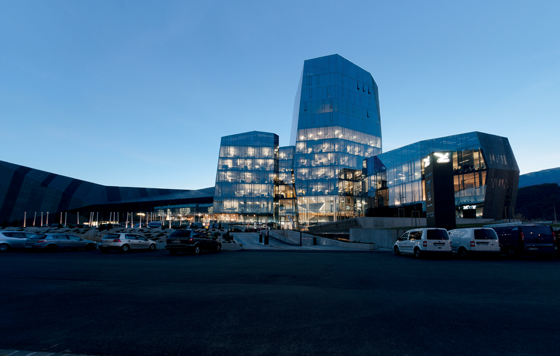Clear Vision: Zumtobel sheds light on the OperAlp/SALEWA Group’s new headquarters
Text by Simon Keane-Cowell
Zürich, Switzerland
12.11.12
More often than not, office architecture can be, well, a little inward-looking. Shut out the outside world and focus staffers' attention on their building's interior spaces and you'll keep them focused on their work. Right? Wrong. The OperAlp/SALEWA Group's new headquarters in Bolzano, Italy, bring the outside in and, thanks to a collaboration with lighting manufacturer Zumtobel, never leave their workers in the dark.
....
Sustainability is here to stay. This we know. But often it's merely name-checked or picked up or put down like an optional extra. Not so when it comes to the OberAlp/SALEWA Group's new HQ in Bolzano, Northern Italy. A ‘Work&Life’ certificate, awarded by the ClimateHouse agency, testifies to the building’s ecological, economic and social sustainability credentials, which, among many others, include a roof-top photovoltaic system which meets the entire building’s energy needs.
But the physical context of the high-performance-sportswear brand group’s new head offices also plays a key role in shaping its design. Situated next to the Alps – where else? – the building brings with it some stunning views.
A key element of the brief to architects Cino Zucchi Architetti und Park Associati was to bring the outside in, allowing employees to see the mountains at any time from within their offices. Blinds were dispensed with throughout. Yet differing daytime brightness levels have a major effect on internal light levels when you’re dealing with a decidedly ‘transparent’ structure.
And herein lies the problem. How do you regulate internal light levels, so that constant lighting conditions are achieved?
To solve this problem, leading lighting manufacturer Zumtobel worked with the architects, Park Associati, to develop the dimmable IBLA luminaire. This wasn’t merely about bald functionality; it was also a question of well-being. ‘The lighting concept makes an essential contribution to creating a working and living environment,’ explains architect Filippo Pagliani of Park Associati, ‘where people feel at ease and which is in harmony with its environment at the same time.’
Beyond the aesthetic value of Zumtobel’s lighting products lies a great deal of commissioned research into the performance, energy efficiency, and effects of artificial lighting. The knowledge that such research produces was also brought to bear on the OberAlp/SALEWA project, which demonstrates how optimum room lighting not only improves staff members’ well-being, but also enhances their performance and willingness to communicate.
Conference rooms feature unobtrusive, recessed luminaires that effect a balanced light distribution, while their variable lighting options allow a precise tailoring of illumination according to need: meetings, presentations and so on. In exhibition and reception rooms meanwhile, uniform general lighting is provided by batten luminaires and focussed display lighting via spotlights, ensuring individual illumination of the products on display.
There’s an additional benefit offered by the IBLA dimmable luminaire in terms of the direct and indirect light that it offers: while the product ensures ideal lighting conditions, this isn’t to the detriment of screen work – computer workstations remain satisfyingly glare-free.
Compelling evidence of the multiple benefits of installing intelligent LED lighting can be found in, among other sources, a Zumtobel comparative study that was conducted recently in collaboration with the Public Works Department of Zurich City Council and Eteam GmbH. Over a four-month period, lighting solutions in two similar corridors at the Werd Administrative Centre were measured and compared. One corridor retained its conventional fluorescent lamps, whose presence detectors turned them off after ten minutes of no activity in the space. The other was installed with LED luminaires. Moreover, the switch-off delay of the presence detectors was reduced, in several stages, down to one minute.
The results of the study were clear: in the case of the LEDs, switching or dimming had no adverse effects on lighting comfort and didn’t cause any wear. What’s more, the LED solution (when factoring in the optimised presence monitoring) consumed a remarkable 81% less power than its fluorescent-lamp counterpart.
Illuminating stuff.











